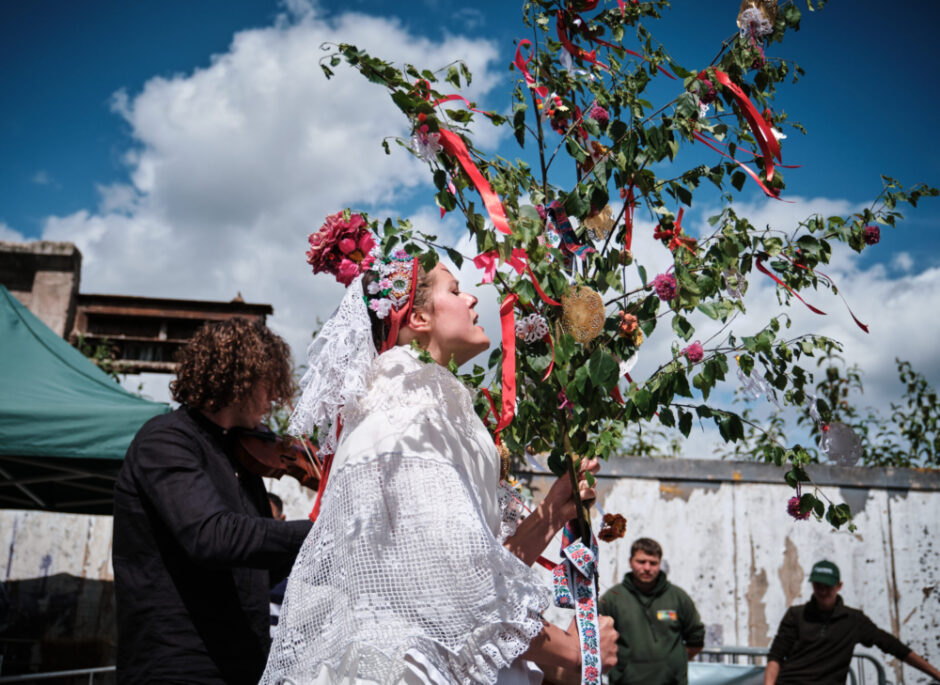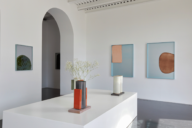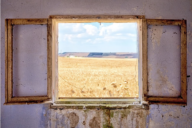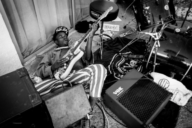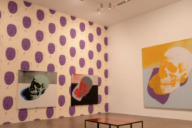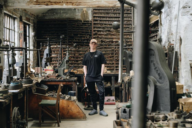LITTLE QUEENS AND EUROPEAN FOLKLORES
Multidisciplinary artist Tereza Buskova explores long-held customs and rituals from European cultures, reinterpreting them with performance, video and print which transcend geographic borders and time placing Women’s experiences at the fore.
Her most recent work, Little Queens, (or Královničky, as the festival is known in the Czech Republic) creatively reimagines an ancient folklore tradition which celebrates nature and the role of women within their communities.
By inviting women from migrant communities to take part, skills such as embroidery, needlework and baking were intertwined to help people express their identities within the intricate cultural context of their adopted home in the UK, bringing new colour, poetry and hope.
Little Queens, which has been funded by Arts Council England, saw women take the roles of the King and the Queens in the parade with both artists and community members dressing in traditionally inspired costumes made by Prague-based designer Mariana Novotná.
The creations produced with the women were used as essential elements during a live procession in the Black Country town of West Bromwich and saw participants holding a mobile lightweight structure made from the completed embroidered pieces. The collaborative performance included creative inputs from Violinist Oliver Clayton, performance artist Zoe Simon and folk artist Karolina Wegrzin.
Here, Tereza explains more about her work and how the oppression of women in some communities shapes her projects and collaborations.
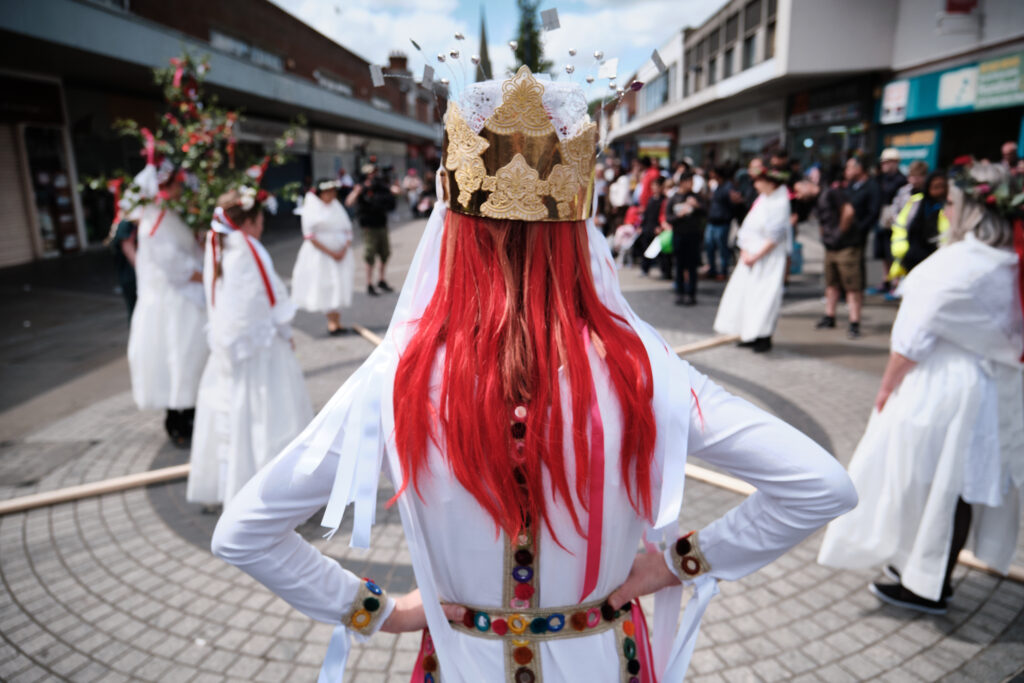
Can you tell us why you chose the Little Queen’s procession for this particular project?
Little Queens evolved through my personal exploration of Bohemian folklore, since I studied at the Royal College of Art. This exploration connects my very personal feelings, relationships and wishes with the world around me. As a woman, mother and migrant it is very natural that it is womanhood, gender and traditions which became central to my work. Some of these are personal reflections explored are painful and traumatic things that happened to me as a woman and migrant.
My earlier work involved literally travelling back to Czech and producing work in small rural villages. The first project which migrated to a more urban UK involved greater collaboration with more diverse communities here in Birmingham. It was the project ‘Clipping the Church’ which took place in Erdington, 2016. This ancient almost forgotten English custom was associated with Mothering Sunday.
In 2019 I began working on Hidden Mothers – its focus was empowerment of women, in particular mothers, who experience isolation and routinely face stigma in the UK. I invited migrant and refugee women from organisations such as MotherShip Projects to stitch Mothers Insignias for the final performance and together with Studio Polpo we encouraged co-design of the final installation through printmaking techniques.
Little Queens built directly on this, aiming to empower both nature and women in a very urban location. Little Queens is the creative reimagining of an ancient tradition, which celebrates nature and the role of women within their communities.
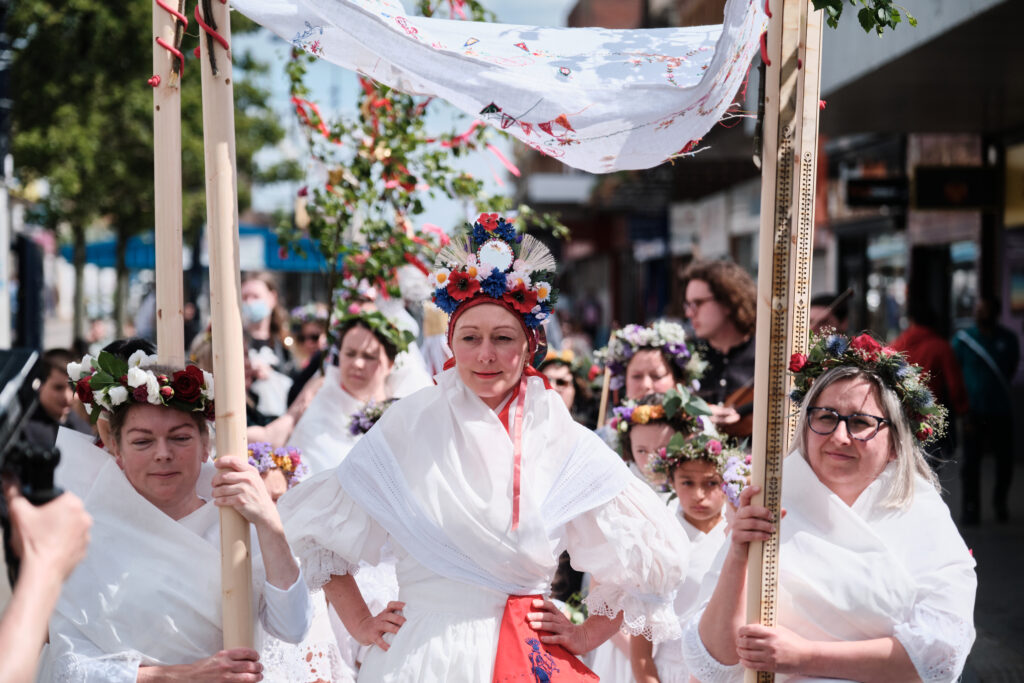
Why do you feel its important to share folklore stories?
We are surrounded by folk stories all the time, they appear through visual symbols, songs, public ceremonies and other forms of everyday situations. To connect with our wider history we need to create more personal stories to which others add their own; this can still occur through craft such as embroidery. But folk art is a more profound phenomena. This goes well beyond the simple conception of national costume, Easter eggs or lace… through the act of making so many people in the world will forever remain nameless and unknown.
Both myself and Birmingham based textile artist Tina Francis, who I worked with on the production of our ceremonial cloth, found already powerful messages in this beautiful piece of fabric as it was already embroidered by an unknown woman. For the Little Queens canopy more stories have been added… individual identities were stitched collectively through symbols. Tina always uses the hashtag #CraftBuildsCommunity and I echo that. Folklore has a specific role: passing on a cultural group’s traditions.
Sometimes people tend to look through folklore rather than really appreciate its hidden spiritual, magical, erotic an often quite dark symbolism. Storytelling brings people together and allow us to learn from each other. I think storytelling can be used to address issues in the society which cannot always be discussed or portrayed directly. They are significant parts of a community’s sociocultural identity. Stories are important for cultural change because people share them, they tell them to each other, they have conversations about them. I am not good with written words, so I prefer to convey stories through conversation and experiences; very sensual, visual and audible experiences. I want participants and viewers to experience them in a very direct way. It puts them in touch with their own emotions and the world, its cultures, and people. I believe that storytelling in art can be a catalyst for cultural change. I believe that if I create something in my mind I can make it real and I can convince others that it’s reality. I believe in magic. I see my art as visionary.
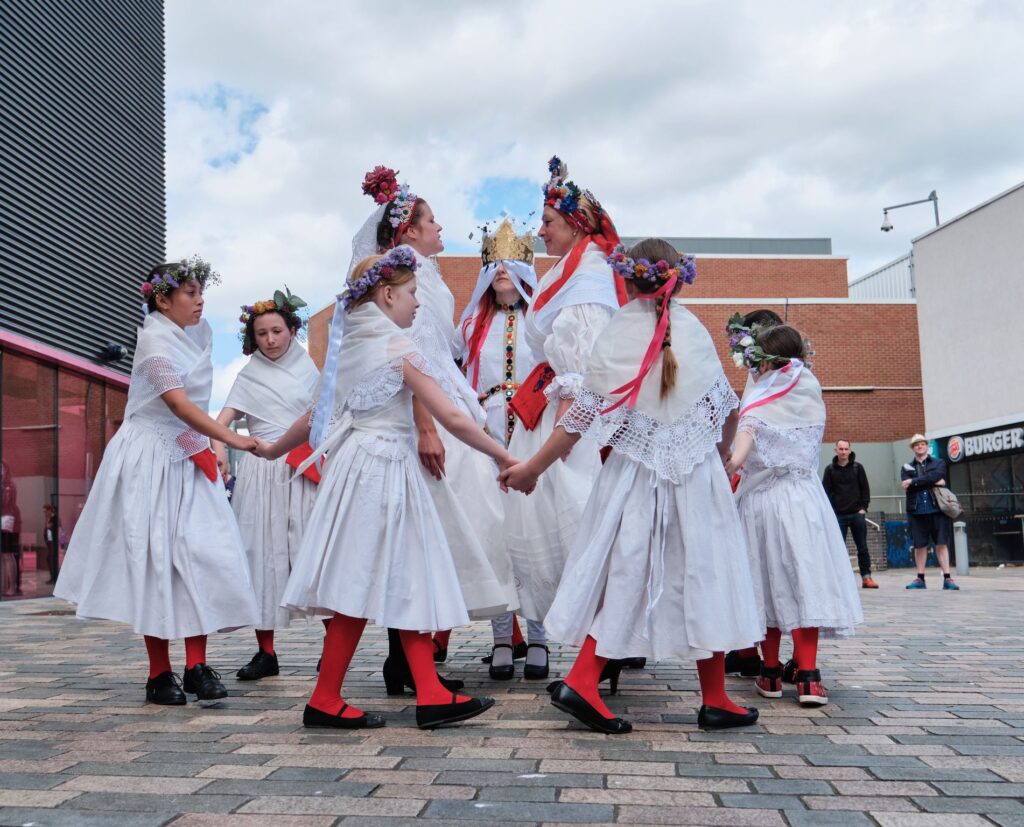
How do you think involving people from all nationalities helps to bring a creative project to life?
I feel more attracted to urban spaces which are being overlooked. For Clipping the Church project I chose Erdington High Street and people asked me why? They imagined the city centre of Birmingham, but I am not looking for wealth and glamour. I prefer places which are less rich with higher rates of migration. When we come to the UK we go where we can afford to live. These places draw people in and have cultural richness.
Both Erdington and West Bromwich had an interesting mix of cultures, including Central and Eastern Europe. Also, it’s about making these places more visible to others. Prior to both projects, I had never visited these communities, same for my family and friends. Women who carried the ceremonial canopy on the West Bromwich High Street were my friends, neighbours and my family. The majority of them were from Czech or Slovakia who now live throughout the UK, however, the embroidered cloth itself was passed through so many women hands, including migrant and refugee women from countries such as Syria, Afghanistan or Russia.
Women and children added bit of their own identity through embroidery and shared stories. I really value the discussion we had. They were nervous to take part in the procession, so I am glad that other migrant mothers carried their work proudly.
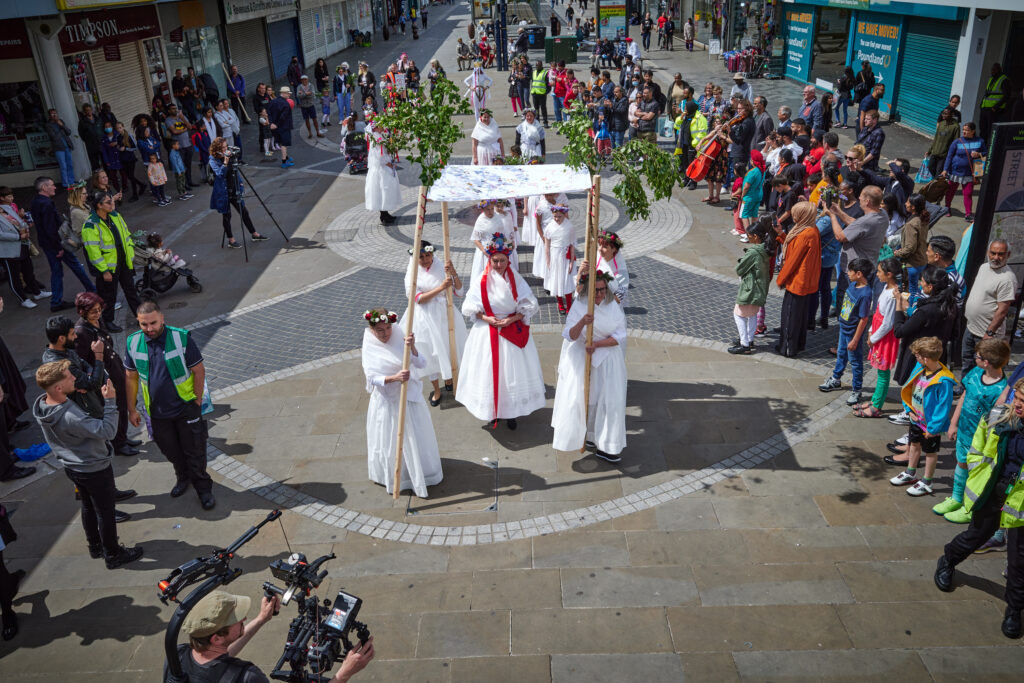
How do you feel creativity can/might lift women’s voices especially in light of the current situation in Eastern Europe?
With wars and economic crises affecting our societies today, it is necessary to understand how power works and what effect it has on traditional cultures. I think that the focus on Central and Eastern European folklore can have a very positive impact. I did this by working with Brushstrokes and MotherShip Projects – which is a community arts organisation in the West Midlands who are championing women, particularly mothers and their children.
I call for coexistence with one another. I can express my ideas freely without any censorship. As an artist I use symbols and suggestions. I prefer ambiguity and to leave the audience to interpret the art in their own way. Naturally Ukrainian was sung in Little Queens, as it was in Hidden Mothers, this isn’t a political message, it is just a natural fact that my work connects with Ukrainians, in the same way that it also connects with other local countries such as Poland. The USSR occupied my homeland with tanks since 1968, but they left in the 1990’s, so my art is free from the kind of political interference which was forced on us.
What are the key messages that you want to share when you are developing your projects?
Subverting patriarchal control, exclusion and the oppression of women is something which I naturally gravitate towards. I mostly focus on rituals where women might be previously have been represented as passive. My visual narratives contradict or challenge this. My work shows female power, beauty and skills. This work is empowering. It illustrates that folklore and social history can instigate change while celebrating Slavic folklore as well as the women, protagonists taking part in the project. Traditional folk customs and traditions can be re-enacted in ceremonial, ritual, dance, magic and other forms of symbolic activities. I see the art as a bridge that communicates between social groups who sometimes have no control over circumstances in their lives. This is something which I have personally experienced. Curator Bar Yerushalmi said to me once “Tereza, I see you as a social changer”.
Lots of textile arts like embroidery are coded as “women’s work” which creates power issues straight away. I think we should celebrat women’s folklore, from textile arts to baking, which I enjoy so much.
Can you tell us a bit about your creative journey (or experience) in the UK? Have you found it inclusive, helpful, nourishing or has it been difficult?
I completed an MA in Fine Art Printmaking at the Royal College of Art. I struggled both financially and academically. The RCA offered a comprehensive range of support structures which allowed me to develop my artistic practice with more confidence. I now see my dyslexia as an integral part of my creativity as a visual artist because visual images are often the starting point in my art. I say my art, but my work would not exist if it weren’t for so many creative artists and musicians. It’s mainly women (Zoe Simon, Mariana Novotna, Bela Emerson or Karolina Wegrzyn) who are at the core of it all. I am more of a conductor who has the vision and directs the orchestra, but their persona, or what is being created, can be contributed to by their creativity. I see our collaboration as equal and mutually rewarding. We work very closely and often form lasting friendships.
I was very lucky to have exhibited at galleries such as David Roberts Art Foundation and Zabludowicz Collection not long after I graduated. I felt supported and nourished.
Any censorship of any kind being placed upon me provokes growth in my art. Projects such as Hidden Mothers carried slightly political context and that has been a little bit challenging. On the other hand, it’s good to step outside of your comfort zone and to push for the impossible without thinking of a plan B. Because of the initial opposition with this project, I was introduced to the directors of the London Festival of Architecture who supported that same project and included my installation which was produced together with Studio Polpo. So far, I have found the UK very nourishing, sometimes more open minded than my homeland.

